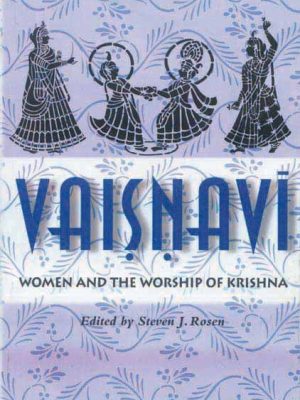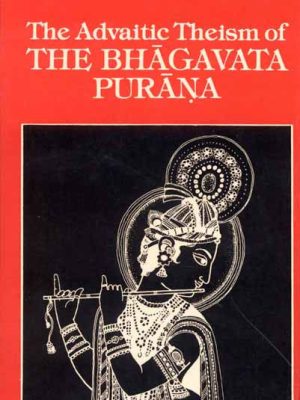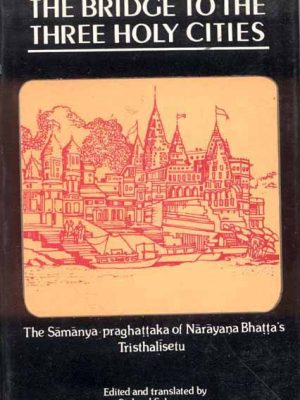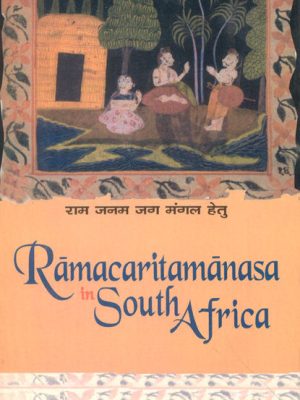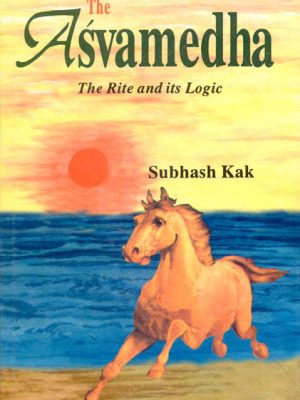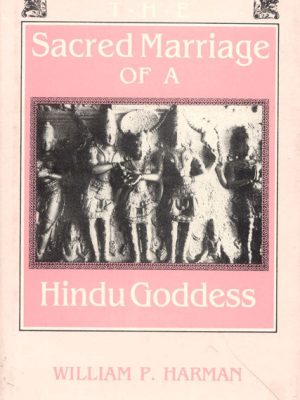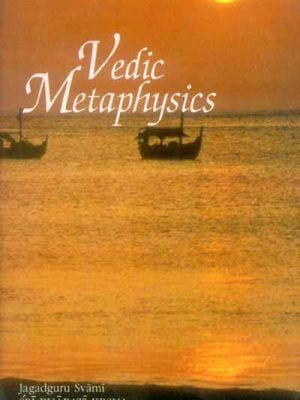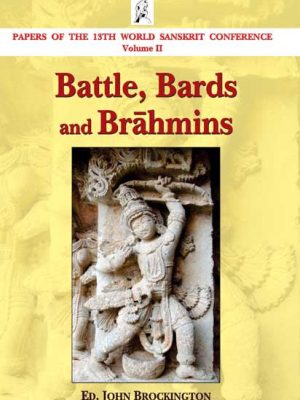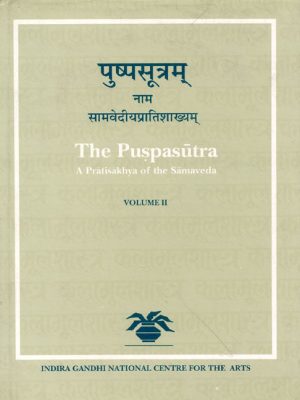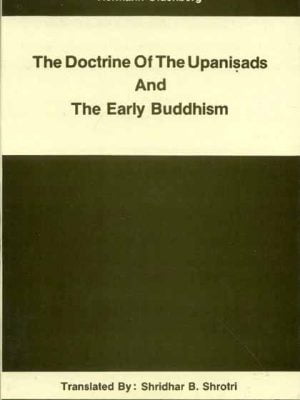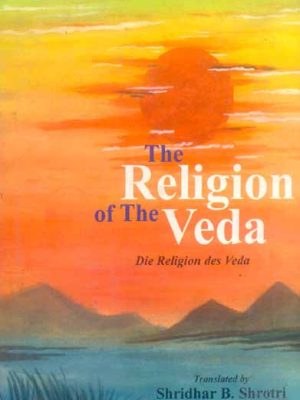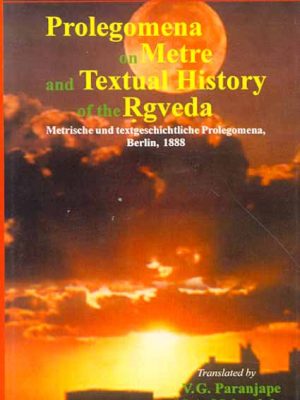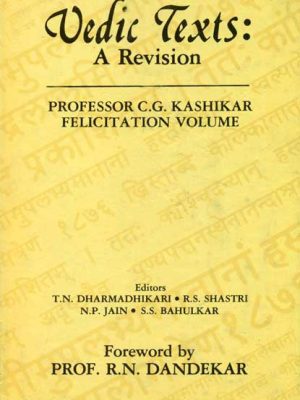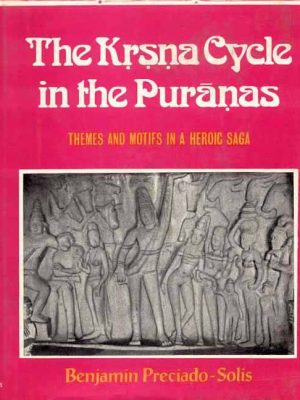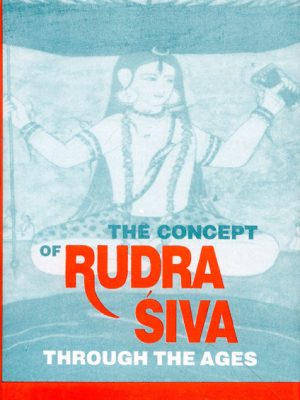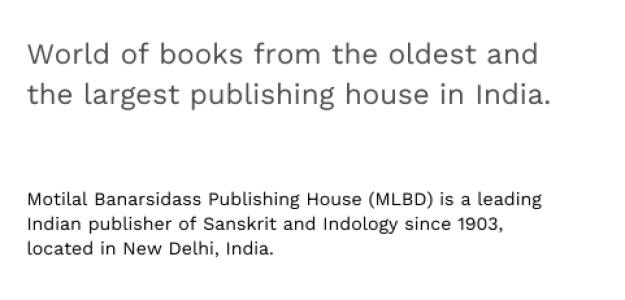
Motilal Banarsidass Publishing House
-
Vaisnavi: Women and the Worship of Krishna
Vaisnavi: Women and the Worship of Krishna
This collection delves into the touchy issue of gender and religion with openness and compassion, with a particular emphasis on Vaishnavism, one of the oldest and most textually rich religious traditions practised by humans. Steven J. Rosen has compiled a collection of eight articles that shed light on the lives of many female saints throughout history as well as the teachings that they left behind. These pieces were written by notable scholars, poets, and practitioners.
Author
Steven J. Rosen
₹725.00 -
The Advaitic Theism of the Bhagavata Purana
The Advaitic Theism of the Bhagavata Purana
The author of this book takes a detailed look at the core beliefs that are outlined in the Bhagavata Purana during the course of its eight chapters. Through in-depth analysis, he demonstrates how the Bhagavata Purana, as a unified scripture, combines Vedantic non-dualism and Vaisnava devotionalism; and how the Bhagavata non-dualism accommodates the reality of the universe and of the individual selves that are found within it within the reality of Brahman. This marvellous combination of the devotionals and non-dualism in the Bhagavata Purana is said to find its expression in the worship of Krsna as a transcendent and ultimate god by all Vaisnavas. This is according to the author. The discussion and delineation found throughout the chapters highlight “each of the major forces” that are responsible for determining “the religious structure of the Bhagavata,” which “has a significance and meaning for the study of religion beyond that of situating a scriptural text within a religious history.” Students of Indian religion and philosophy will find the current academic work to be very interesting and valuable. The general reader who is interested in Indian history and culture will also find a place for it in their collection of literature..
Author
Daniel P. Sheridan
₹595.00 -
The Bridge to the Three Holy Cities: The Samanya-praghattaka of Narayana Bhatta’s Trishalisetu
The Bridge to the Three Holy Cities: The Samanya-praghattaka of Narayana Bhatta’s Trishalisetu
In the Hindu tradition, the study of holy locations and pilgrimages to such places is considered to be a sub-field of the Dharmasastra. This sub-field is known as tirtha. The “Bridge to the Three Holy Cities” (also known as “Tristhalisetu”) of Narayana Bhatta, which was composed in Varanasi in the 16th century A.D., is regarded as the canonical and most authoritative work of the extensive tirtha literature. It was authored by Narayana Bhatta. The book is divided into four parts, but only the third, fourth, and final parts were included in the Anandasrama version that came out in 1915. The first, or “General,” Section of the Samanya-praghattaka, which was not included in that edition, discusses the concept, definition, and distinguishing characteristics of tirthas, and prescribes in detail the procedures and practises of a pilgrimage. However, this section was omitted from that edition. Both a critical edition of the text of the Samanyapraghattaka as well as a translation that has been annotated are included in this book. The practise of making pilgrimages is an important part of Hinduism, and this literature provides a variety of knowledge relevant to that subject.A
Author
Richard Salomon
₹995.00 -
Ramacaritamanasa in South Africa
Ramacaritamanasa in South Africa
Through the strong medium of Awadhi, Gosvami Tulsidasa’s Ramacaritamanasa conveyed to the world the message of Ramabhakti and the principles of Ramarajya. Indentured workers from Uttar Pradesh and Bihar brought the Ramacaritamanasa all over the world three hundred years after it was written down. This allowed it to be read in every corner of the globe. Between the years 1860 and 1911, many thousands of these labourers made their way to South Africa, bringing with them copies of the Ramacaritamanasa to serve as their central religious text.
This book provides an in-depth analysis of the Ramacaritamanasa’s function in the daily lives of Hindi-speaking indentured labourers, as well as their perspectives on Sri Rama and the Ramacaritamanasa. Additionally, the book discusses the indentured labourers’ progency in South Africa. It is clear that Tulsidasa’s goal of instilling a selfless devotion to Sri Rama as the Supreme Deity is being accomplished via the Ramacaritamanasa until this very day. The social and political message that Tulsidasa conveyed also received a great deal of appreciation at the time.
The Ramacaritamanasa is revered as a sacred text among South African Hindus whose ancestry is from Hindi, and these individuals seek peace and direction by immersing themselves in Sri Rama’s Act as deeply as possible. Its function among Hindi-speaking Hindus as a maintainer of religious and cultural traditions is a clear indication of the significance it will continue to have in the next year.
Author
Usha Devi Shukla
₹495.00Ramacaritamanasa in South Africa
₹495.00 -
The Asvamedha: The Rite and its Logic
The Asvamedha: The Rite and its Logic
This article explains many specific characteristics of the Vedic sacrificial system by describing the ritual known as “Asvamedha” and the symbolism associated with it. Within the framework of Vedic epistemology, a number of inquiries about the Asvamedha are addressed, along with their respective answers. This rite serves three important purposes: I it presents an equivalence of the naksatra year to the heaven, implying that it is a rite that celebrates the rebirth of the Sun; (ii) it is symbolic of the conquest of Time by the king, in whose name the rite is performed; and (iii) it is a celebration of social harmony that has been achieved by the transcendence of the fundamental conflicts that exist between various sources of The comprehension of numerous of its particulars is aided by the use of numerical concepts taken from another Vedic ritual known as the Agnicayana.
Author
Subhash Kak
₹250.00 -
The Sacred Marriage of a Hindu Goddess
The Sacred Marriage of a Hindu Goddess
In the region of southern India known as Tamil Nadu, the city of Madurai is the location where Hindus celebrate the union of the goddess Minakshi and the god Siva. The yearly festival lasts for 10 days and is considered to be one of the most important and well-known of all Hindu celebrations. This event is investigated in the work of William Harman from a variety of viewpoints, including the history of religions, Sanskrit and Tamil traditions, and Hindu cultural norms.
Author
WILLIAM P. HARMAN
₹595.00 -
Vedic Metaphysics
Vedic Metaphysics
In 1958, a Sankaracarya travelled to the western regions of India for the very first time in the country’s history. It was at the request of the Self Realization Fellowship in Los Angeles that the author, His Holiness Jagadguru Sankaracarya Sri Bharati Krsna Tirtha of Puri, travelled to the United States to disseminate information on Vedanta. This book is a collection of several of his lectures that were presented at that location.
The fundamentals of Vedanta are outlined in these lectures, which were delivered by a saint-yogi who was both an expert in the ancient Indian texts and was knowledgeable in the current sciences. They speak in a clear and concise manner while maintaining the integrity of their thoughts. Given that they are written in the present vernacular, it is likely that the modern mind will find them to be especially suitable. Despite being directed for American audiences, the talks share a message that is both timeless and applicable everywhere else in the world. The readers will find that the stages of spiritual inquiry and the routes to God-realization that are explained in these passages are of an enormous amount of practical value to them in their search for the sublime.
The Most Reverend Jagadguru Sankaracarya One of the four monasteries that the great Sankara established in the distant past, the Govardhana Pitha in Puri was led by Sri Bharati Krsna Tirtha, who served as the pontifical head of the monastery. After an outstanding academic career that included the study of Sanskrit, Mathematics, Philosophy, History, English Literature, and other scientific subjects, he studied Vedanta under the renowned Jagadguru Sankaracarya, Sri Sivabhinava-Nrsimha-Bharati at Sringeri, and he practised vigorous yogasadhana in the nearby forests. It was in these forests that he also discovered the hidden meaning of the Ganita-sutras of He accepted sannyasa in 1919.
Sainthood was not His Holiness’ only vocation; he was also a scholar, a religious speaker, a yogi-philosopher, and an orator. He had a profound understanding of the Hindu texts. In addition to this, he studied the sacred texts of other faiths with the reverence of a devotee and proclaimed the fundamental oneness of all world religions.
His Holiness established the World Reconstruction Association in 1953. This was a non-religious organisation with the goal of morally reorganising society as the primary focus of its activities. In 1960, he acquired the state of Mahasamadhi.\Author
JAGADGURU SVAMI SRI BHARATI KRSNA TIRTHAJI MAHARAJA
₹795.00Vedic Metaphysics
₹795.00 -
Battle, Bards and Brahmins: Papers of the 13th World Sanskrit Conference Volume II
Battle, Bards and Brahmins: Papers of the 13th World Sanskrit Conference Volume II
This volume, the second in the Proceedings of the 13th World Sanskrit Conference (Edinburgh, July 2006), reflects the continued increase in interest in the Sanskrit epics seen in recent years, containing no less than 19 articles (a larger number than in the corresponding volume from the 12th WSC at Helsinki) by a number of distinguished scholars in the section devoted to the Sanskrit epics. The great majority of the articles focus on the Mahabharata but several focus on the Ramayana, as well as one on the Harivamua. The variety of approaches adopted by their authors underlines the vitality of this area of research and collectively these articles make a major contribution to our understanding of the history of these massive works, their relationship to each other and their place in the total field of Sanskrit literature and indeed of Indian literature and culture as a whole. The articles are grouped according to the text that they are mainly focussing on (in the order Mahabharata, Harivamsa, Ramayana) and within that in an order which seeks to bring related topics together, beginning with the genealogical issues that underpin all of the narrative in each of the texts and ending with the study of a retelling of one of them, the Anandaramayana. The editor has ensured a degree of uniformity of appearance and of bibliographic reference but had no wish to rein in the diversity of expression and approach to be found in the feast of articles here assembled.
Author
JOHN BROCKINGTON
₹750.00 -
The Puspasutra (2 Vols.): A Pratisakhya of the Samaveda
The Puspasutra (2 Vols.): A Pratisakhya of the Samaveda
One of the most important supplementary works in the body of Saman technical literature that is associated with the Kauthuma and Ranayaniya schools is known as the Puspasutra. It discusses the melodies of the Saman people as well as the structure of their music. In the context of this discussion, the word “Puspa” refers to the syllabic expansion that takes place throughout the process of creating a melody out of a verse. The Puspasutra was penned a significant amount of time after the Saman melodies had already been formed.
There are 10 Prapathaka included in the Puspasutra. The first two of them include the names of Samans that appear in the Uttaragana (also known as the Uhagana and the Uhyagana) in the sequence in which they appear in the Uttaragana. The demarcation may be understood based on the declaration of themes that is included in the eighth Prapathaka of the Puspasutra. The Puspasutra is divided into two sections: the northern and the southern recessions. The statement of contents found in the eighth Prapathaka is in complete agreement with the subjects discussed in Prapathakas III to VIII of the southern recession. It is generally agreed that this section of the Puspasutra is the authentic, original component of the text
The Northern recension of Puspasutra attributes this [ext] to Govila not once, but twice. It was formerly attributed to Vararuci, according to the Southern recension. In several places, the Puspasutra describes the chants in detail, including their metres. This gives the appearance that the ganas were repeated in a different metre than what they really were.
It is not easy to pinpoint the precise year when the Puspasutra was written. The initial nucleus was expanded upon by include other components, such as the Vikalpas (alternatives), the remaining bhavas, a more in-depth study of prastava, and the first two Prapathakas. The fact that it now exists with 10 Prapathakas is a significant boon to the academic community that is dedicated to the study of Samavedic chanting. It’s possible that the readers may find the explanations of the technical jargon offered in this version to be really helpful.About the Author(s)
G.H. TARLEKAR
₹1,695.00 -
The Doctrine Of The Upanisads And The Early Buddhism
The Doctrine Of The Upanisads And The Early Buddhism
The first edition of this book was released in 1908.
Oldenberg gives a brief overview of the life and philosophy of Vedic Indians in the introduction of his book. During this time period, a magician may eventually advance to the role of a priest as a result of their advancement. The Vedas and the Brahmanas were written during this time period.
In Chapter I, which delves into the more ancient Upanisads, such as the Brhad Aranyaka Upanisad and the Chandogya Upanisad, it is first described how the concept of the Supreme Being, the one and only mystic power, was conceived in the words Brahman and Atman, and how these two entities merged with each other and became identical. This is done in the context of Chapter I’s discussion of the older Upanisads. After then, it moves on to a discussion of the theory of metempsychosis, which focuses on how it developed as a result of the relationship between the Supreme Being and the world of plurality. During this time, the magician-priest starts to transition into more of a philosophical role.
Chapter II deals with subsequent Upanisads such Kathaka Upanisad, Maitrayana Upanisad and Svetasvatara Upanisad. During this time period, there are convincing indications that the Samkhya Doctrine and the Yoga were only starting to take shape as distinct systems. Here, the culmination of human aspiration, the deliverance of oneself from anguish, is laid bare for everyone to see. In a nutshell, we see the evolution of thinking in Indian philosophy from a god of impersonal powers to a deity of personal powers.
However, it is noteworthy to note that a system that firmly supports the aspects of Yoga also strongly rejects theism and adheres to the gloomy philosophy of Indian mysticism, which is the Doctrine of Buddhism. This is discussed in further detail in Chapter III.
Author
Hermann Oldenberg
₹695.00 -
The Religion of the Veda: Die Religion des Veda
The Religion of the Veda: Die Religion des Veda
The Vedic Literature, which is the oldest product of the Aryan mind and is held in the highest esteem and is regarded as the most sacred by Hindus, presents a panorama of the life of the ancient population of India in all of its facets. Vedic Literature is the oldest product of the Aryan mind and is held in the highest esteem. Herman Oldenberg was the professor who pioneered the first critical examination of frightening literature in the last several centuries, and European academics, mostly Germans, were the ones who conducted the research. His masterpiece, titled Die Religion des Vedas, was published for the first time in 1894, and a revised version was released in 1916. In his thorough and in-depth research on the Vedic religion, he took use of linguistic approaches, as well as those from the fields of ethnology and folklore. This work has had a significant influence on subsequent Vedic studies and has an enduring interest to the student of the Veda, as is amply evident from the fact that even after nearly a century has passed since its first publication, it continues to attract the attention of Vedic researchers and is very frequently sought for guidance and consultation by them, and here is the first ever English translation of these four classic texts.
The book is divided into four chapters, each of which is preceded by an introduction that provides a comprehensive discussion of the source material, which includes the Vedas, Brahmanas, and sutra. The first chapter discusses the gods and demons of the Vedic tradition in general, while the second chapter delves into the specific gods of the Vedic tradition, including Agni, Indra, Vruna Mitra, and others, as well as the bad demons, the beginning of the universe, and the divine and moral realms. The third chapter discusses in depth the religion of sacrifice, which includes topics such as magic observances, festivals, prayer, and priests. The fourth chapter discusses animism, the dead, soul heaven, and ell, as well as ghosts, fathers, and burial ceremonies.
Author
HERMANN OLDENBERG
₹995.00 -
Prolegomena on Metre and Textual History of the Rgveda: Metrische und textgeschichtliche Prolegomena, Berlin, 1888
Prolegomena on Metre and Textual History of the Rgveda: Metrische und textgeschichtliche Prolegomena, Berlin, 1888
Oldenberg made a distinction between the “original text” of the Rgveda, which is the form in which the rsis composed and recited their hymns, and the “traditional text,” which has been handed down to us in a fixed form by the oral tradition. The “original text” of the Rgveda is the form in which the rsis composed and recited their hymns. Oldenberg conducted a comprehensive analysis of all parts of the traditional text in order to give the original text to the academic community in the form and arrangement that he had uncovered. This was done so that other researchers may benefit from his findings. Oldenberg always intended for the contents that are now being published in this book to serve as a Preface to his planned edition of the Rgveda. This volume is now being published. They are the product of Oldenberg’s in-depth research on the Vedic metre, the principles that underlie the arrangement of the hymns in the Rgveda Samhita, the variations found in the text of the mantras as found in the Rgveda and the later Samhitas and the Brahmanas, orthoepic diaskeuasis, and the two Sakhas of the Rgveda: Sakala and Baskala. Later on, Oldenberg decided against releasing his ‘critical edition’ of the Rgveda as he had originally intended.
Author
HERMANN OLDENBERG,
TRANSLATED BY: V.G. PARANJAPE & M.A. MEHENDALE
₹895.00 -
Vedic Texts: A Revision: Professor C.G. Kashikar Felicitation Volume
Vedic Texts: A Revision: Professor C.G. Kashikar Felicitation Volume
The compilation of critical editions of Vedic texts, which was being done at the time by a number of different Vedic Scholars in India, resulted in the publication of Vedic Texts: A Revision. On the occasion of Prof. C.G. Kashikar’s eightieth birth anniversary, this volume, which consists of the specimens of the forthcoming critical editions of Vedic Texts, is presented to him as a tribute of respectful gratitude for his profound scholarship in the field of Vedic ritualistic studies. The specimens are presented in this volume as a tribute of respectful gratitude. This volume contains excerpts from eight different Vedic books, including the Maitrayani Samhita, Gopatha Brahmana, Aitareya Aranyaka, Baudhayana Srautasutra, and Manava Srautasutra. The academics who have been tasked with the revision of these eight works are already relatively acquainted with the individual works, as well as conversant with the appropriate method of operation. In addition, this volume has a foreword written by Professor R.N. Dandekar, a biographical sketch, biodata, and a bibliography of Professor C.G. Kashikar’s publications and a selection of his papers.
Author
C. G. Kashikar
₹500.00 -
The Krsna Cycle in the Puranas: Themes and Motifs in a Heroic Saga
The Krsna Cycle in the Puranas: Themes and Motifs in a Heroic Saga
Krsna is often regarded as one of the most beloved personalities in Indian literature and religion. The accounts of his life and the actions he performed continue to play an important role in the literary traditions of India right up to the present day. The primary ideas and recurrent images that can be seen throughout the Krsna mythology up to the 10th century are the focus of this book. In the first chapter, the antecedents of the figure of Krsna that may be found in the Vedas are investigated, as are some of the viewpoints that suggest that Krsna can be found in the hymns of the Vedas. An exhaustive survey is made of all of the archaeological and literary evidences, along with their interpretations and discussions by modern scholars, and the second chapter deals with the first historical evidence on Krsna up to the beginning of the Christian Era. This chapter covers the time period from the beginning of the Christian Era to the beginning of the Christian Era. In the third and fourth chapters, an examination of the motifs and themes found in the Krsna saga is presented using a folk-comparative methodology. Particular focus is placed on the parallels between the Krsna saga and the mythology surrounding Hercules. The last chapter provides an overview of the Krsna tales as they were shown in iconography up to the 10th century. In addition to this, there is a collection of images that depict the majority of the iconographical evidence that has been addressed; several of these photographs are being released for the first first time here.
Author
DR. BENJAMIN PRECIADO-SOLIS
₹1,000.00 -
Concept of Rudra-Siva Through the Ages
Concept of Rudra-Siva Through the Ages
The current book sheds fresh information on the progressive growth of the notion of Rudra-Siva in his animal, phallic, and human forms from the days of the Harappa Civilization. This development can be traced back to when the Harappa Civilization existed. It investigates how Siva, the composite Aryan-non-Aryan Divinity, was not only admitted but was ultimately crowned with an exalted position in the Brahmanical pantheon; how the bull, which was once identified with the deity, was regulated to the position of a vahana; how phallism was related to Saivism; and also how Siva, in his different forms, was represented in early Indian Art and the Art of Further India. Because of the breadth and depth of the author’s research, he has been able to fill an important need in the field, and his approach to the topic as a whole is unmatched. A comprehensive bibliography is included in this rigorous research on Siva that was conducted.
Author
MAHADEV CHAKRAVARTI
₹995.00
